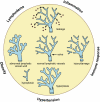Current views on the function of the lymphatic vasculature in health and disease
- PMID: 20889712
- PMCID: PMC2947764
- DOI: 10.1101/gad.1955910
Current views on the function of the lymphatic vasculature in health and disease
Abstract
The lymphatic vascular system is essential for lipid absorption, fluid homeostasis, and immune surveillance. Until recently, lymphatic vessel dysfunction had been associated with symptomatic pathologic conditions such as lymphedema. Work in the last few years had led to a better understanding of the functional roles of this vascular system in health and disease. Furthermore, recent work has also unraveled additional functional roles of the lymphatic vasculature in fat metabolism, obesity, inflammation, and the regulation of salt storage in hypertension. In this review, we summarize the functional roles of the lymphatic vasculature in health and disease.
Figures



Similar articles
-
The Lymphatic Vasculature in the 21st Century: Novel Functional Roles in Homeostasis and Disease.Cell. 2020 Jul 23;182(2):270-296. doi: 10.1016/j.cell.2020.06.039. Cell. 2020. PMID: 32707093 Free PMC article. Review.
-
Lymphatic vascular morphogenesis in development, physiology, and disease.J Cell Biol. 2011 May 16;193(4):607-18. doi: 10.1083/jcb.201012094. J Cell Biol. 2011. PMID: 21576390 Free PMC article. Review.
-
Building the drains: the lymphatic vasculature in health and disease.Wiley Interdiscip Rev Dev Biol. 2016 Nov;5(6):689-710. doi: 10.1002/wdev.246. Epub 2016 Aug 30. Wiley Interdiscip Rev Dev Biol. 2016. PMID: 27576003 Review.
-
Lymphatic vessels in health and disease.Wiley Interdiscip Rev Syst Biol Med. 2013 Jan-Feb;5(1):111-24. doi: 10.1002/wsbm.1201. Epub 2012 Dec 3. Wiley Interdiscip Rev Syst Biol Med. 2013. PMID: 23209022 Free PMC article. Review.
-
Zebrafish provides a novel model for lymphatic vascular research.Methods Cell Biol. 2011;105:223-38. doi: 10.1016/B978-0-12-381320-6.00009-6. Methods Cell Biol. 2011. PMID: 21951532
Cited by
-
Lymphatic and angiogenic candidate genes predict the development of secondary lymphedema following breast cancer surgery.PLoS One. 2013 Apr 16;8(4):e60164. doi: 10.1371/journal.pone.0060164. Print 2013. PLoS One. 2013. PMID: 23613720 Free PMC article.
-
Molecular pathways governing development of vascular endothelial cells from ES/iPS cells.Stem Cell Rev Rep. 2013 Oct;9(5):586-98. doi: 10.1007/s12015-013-9450-7. Stem Cell Rev Rep. 2013. PMID: 23765563 Review.
-
Gua Sha, a press-stroke treatment of the skin, boosts the immune response to intradermal vaccination.PeerJ. 2016 Sep 14;4:e2451. doi: 10.7717/peerj.2451. eCollection 2016. PeerJ. 2016. PMID: 27672506 Free PMC article.
-
Biological rationale for the design of polymeric anti-cancer nanomedicines.J Drug Target. 2013 Jan;21(1):1-26. doi: 10.3109/1061186X.2012.723213. Epub 2012 Sep 26. J Drug Target. 2013. PMID: 23009337 Free PMC article. Review.
-
Renal lymphatic vessel dynamics.Am J Physiol Renal Physiol. 2020 Dec 1;319(6):F1027-F1036. doi: 10.1152/ajprenal.00322.2020. Epub 2020 Oct 26. Am J Physiol Renal Physiol. 2020. PMID: 33103446 Free PMC article.
References
-
- Achen MG, McColl BK, Stacker SA 2005. Focus on lymphangiogenesis in tumor metastasis. Cancer Cell 7: 121–127 - PubMed
-
- Adams RH, Alitalo K 2007. Molecular regulation of angiogenesis and lymphangiogenesis. Nat Rev Mol Cell Biol 8: 464–478 - PubMed
-
- Alders M, Hogan BM, Gjini E, Salehi F, Al-Gazali L, Hennekam EA, Holmberg EE, Mannens MM, Mulder MF, Offerhaus GJ, et al. 2009. Mutations in CCBE1 cause generalized lymph vessel dysplasia in humans. Nat Genet 41: 1272–1274 - PubMed
-
- Amann-Vesti BR, Franzeck UK, Bollinger A 2001. Microlymphatic aneurysms in patients with lipedema. Lymphology 34: 170–175 - PubMed
Publication types
MeSH terms
Grants and funding
LinkOut - more resources
Full Text Sources
Other Literature Sources
Medical
